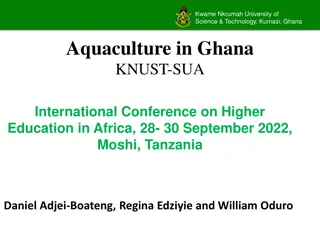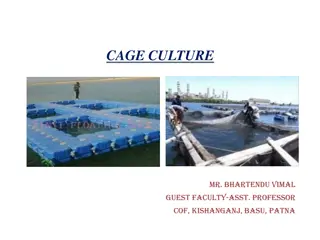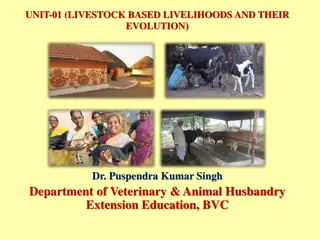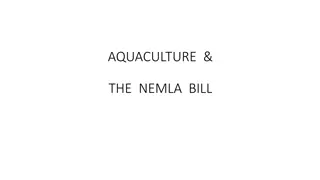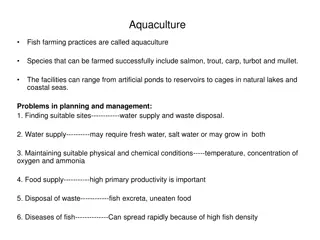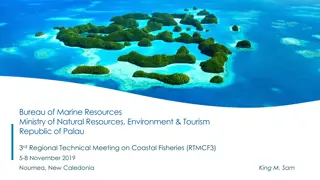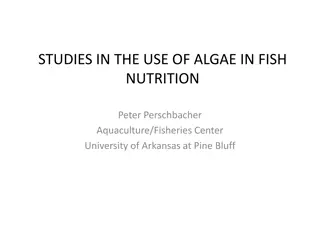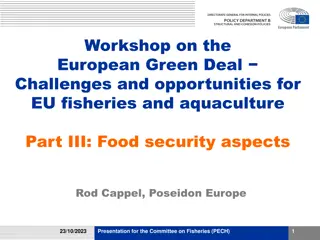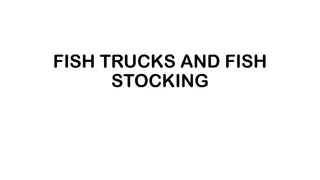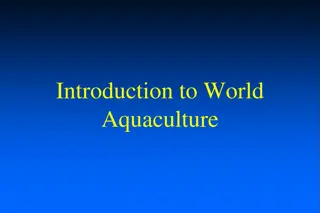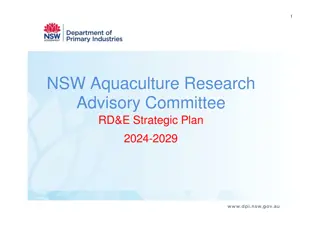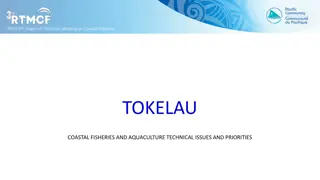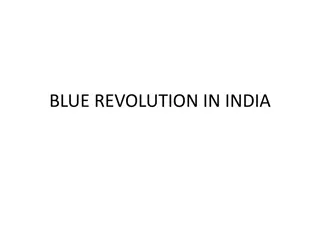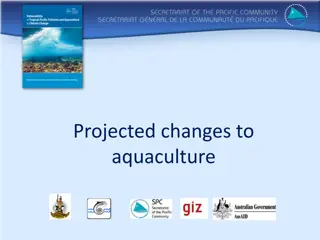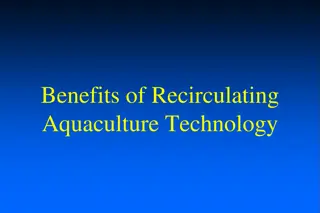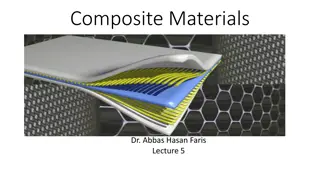Composite Fish Farming: An Innovative Aquaculture Technique
Composite fish farming is a popular aquaculture technique where different compatible fish species are cultured together in ponds to maximize fish production. Researchers from India and abroad have contributed significantly to this field. The practice involves combining Indian major carps like Catla, Rohu, and Mrigal, along with exotic carps, to enhance farm productivity. Proper pond reclamation and removal of predatory and weed fishes are essential steps in setting up a successful composite fish farming system.
Download Presentation

Please find below an Image/Link to download the presentation.
The content on the website is provided AS IS for your information and personal use only. It may not be sold, licensed, or shared on other websites without obtaining consent from the author. Download presentation by click this link. If you encounter any issues during the download, it is possible that the publisher has removed the file from their server.
E N D
Presentation Transcript
Dr. Saumen Chakrabarti Associate Professor Department of Zoology Women s College Agartala, Tripura
The technology developed for fish culture in which more than one type of compatible and non- competing fishes are through the utilization of different feeding zones (all the natural niches) in a pond so as to increase the total fish production from unit area of water body is known as composite fish farming and it is the most popular culture technique in the country. cultured simultaneously Farmers can easily take up composite fish culture in village ponds and can improve their financial position substantially.
Several noteworthy researchers (Bhuiyan 1970; Lakshmanan et al. 1971; Sinha et al.1973; Murty et al. 1978 ; Haque and Ray, 1983; Shang and Costa-piere ,1983; Vasanthakumar and Selvaraj 1985; Michael, 1988; Li and Mathias, 1990; Lutz, 2003 ; Biswas et al.1991; Dewan et al. 1991; Wahab et al.1991; Milstein, 1992; Ghosh et. al. 1993; Tripathi et al. 2003; Azad et al. 2004; Chandra et al., 2005; Mahapatra et al. 2006; Parvez et al. 2006; Rahman et al. 2006; Hussain et al. 2011; Hussain et al.2013) of India and abroad worked on composite fish farming. Sinha et al.1985;
Fish species involved in composite fish culture A. Culture of Indian major carps are grown together In India, Indian major carps namely Catla(Catla catla), Rohu(Labeo rohita) and Mrigal(Cirrhinus mrigala) are stocked and grown together in the same pond. B. Culture of Indian major carps and Exotic carps together In such culture practices, Indian major carps namely Catla(Catla catla), Rohu(Labeo rohita) and Mrigal(Cirrhinus mrigala) and exotic carps namely Common carps(Cyprinus carpio), Silver carps (Hypophthalmicthys molitrix) and Grass carps (Ctenopharyngodon idella) are stocked and grown together in the same pond.
Type of fish 4 species combination 5 species combination 6 species combination Catla 30% 30% 10% Rohu 15% 15% 15% Mrigal 30% 25% 20% Common carp 25% 20% 20% Silver carp - - 25% Grass carp - 10% 10%
1. Reclamation of pond This is done by removing useless weeds and muddy earth of the bottom. It is better to make the pond rectangular in shape. Care is to taken so that the depth of water does not become more than two meters. 2. Removal of predatory and weed fishes Predatory fishes are Channa sp.(Lata, Chang, Sal, Sol), Anabas sp.(Koi), Clarias sp.(Magur), Wallogonia sp.(Boal) and Weed fishes such as Puntius sp.(Puntis), Oxygaster sp.(Chala), Gudusia sp.(Khoira)etc. will be removed from the cultured pond by using fish poisons like Mahua oil cake(Brassia latifolia). 3. Application of quicklime Addition of quick lime which increases the fertility of the pond and keep the fishes healthy. 200-500 kg of quick lime per hectare is recommended dose.
4. Application of Fertilizers and manures Fertilisation of the pond is an important means of intensifying fish culture by increasing the natural productivity of the pond. The fertiliser programme has to be suitably modified depending on the growth of the fish, available food reserve in the pond, physico-chemical conditions of the pond. Fertilizers are of two types, inorganic and organic and they are applied in phases. Common fertilizers are cow dung, single superphosphate, Triple superphosphate, Ammonium sulphate, Urea etc. Organic manure to be applied after a gap of 7-10 days from the date of liming. 5. Stocking of fish fry in the pond Fish fry about 1.0-1.5 cm in length are to be let loose in the ponds three weeks after the application of (first phase) fertilizers. 6. Number of fish fry recommended per ha of pond Number of fish fry per ha of pond should be between 5000-7500.
Application of supplementary food Supplementary food in the form of mustard oil cake, rice bran etc. aids in the rapid growth of the fishes. Fishes in the pond can be fed with a mixture of rice bran and oil cakes in the ratio of 4:1. Fish feed can be placed in a feeding bag and should be lowered down to the bottom of the pond or feed can be dispersed at the corners of the pond. For a pond of one ha with 5000-7500 fish fry , the requirements of supplementary food are -
Period Amount of supplementary food(kg/day) 4 kg/day During 1stmonth to 2ndmonth During 3rdmonth to 4thmonth 6 kg/day During 5thmonth to 6thmonth 10kg/day During 7thmonth to 8thmonth 14kg/day During 9thmonth to 10 month 18kg/day During 11thmonth to 12thmonth 24kg/day
Harvesting For table use, fishes may be netted after culturing for a year or when the fishes become 750- 1,000 gm in weight. Harvesting can be done by partial de-watering Yield in composite fish culture With proper scientific management, fish production of 4 to 6 tons/ha can be achieved in a year.
Rate(Rs./unit) Amount Sl. No. Items Capital cost 1. Excavation of land(4000 m3) 25 /m3 1,00,000/= - 2. Construction of sluice gate(inlet/outlet) 25,000/= 3. Fish seed(4000 fingerlings) 3 12,000/= 4. Liming(200 kg) 15 3,000/= 5. Fertilizers & Manures 20,000/= 6. Supplementary feeding(6000 kg) 30 1,80,000/= 7. Regular investments(including labour) 60,000/= 8. Total investment 4,00,000/= 9. Total investment(excluding capital investment) 4,00,000-1,00,000 3,00,000/= 10. Total fish production(Approx.4500kg) Rs.100/kg 4,50,000/= 11. Net income per year 4,50,000-3,00,000 1,50,000/= 12 Net income per year 12,500/=
Composite fish culture of compatible fish species is the most favoured fish culture practice because this facilitates efficient utilization of all ecological zones within pond environment enhancing the maximum standing crop (Lutz, 2003). In some cases, one species enhances the food availability for other species and thus increases the total fish yield per unit area. Selection of species plays an important role for any culture practices. For efficient utilization of different strata and zones of a pond, three or more species need to be stocked.
In current fish culture set up three Indian carps Catla catla, Labeo rohita, Cirrhinus mrigala and two Chinese carps, silver and grass carp are considered the best combination (Rahman et al., 2006). Utilization of homestead organic waste, in polyculture carp proves to be the harmless for physico-chemical properties of water. Cirrhinus mrigala and C. carpio responded best in manured ponds with homestead organic wastes (Parvez et al., 2006). Milstein et al. (2002) reported that farmers prefer to stock C. carpio as a bottom feeder instead of C. mrigala because C. carpio grows faster than C. mrigala and the overall production is higher when combined with L. rohita and C. catla in polyculture ponds.
In polyculture system fish species combinations, fish stocking density ratio and nutrient input quality and quantity are the management factors that predisposed the amounts of these natural foods in ponds. The feeding behaviour of fish has a significant influence on natural food quantity. Benthivorous fishes enhance oxygen availability in the sediment and cause re-suspension of bottom particles by digging and sieving of sediments which has a large impact on the abiotic and biotic properties of the overlying water column of the pond (Hussain et al., 2011).
The standard recommended composite fish culture in India involves the combination of three species of Indian major carps with three exotic carps, depending on the market demand and resource availability. With the adoption of technology of composite carp culture, production levels of 3-5tonnes/ha/yr could be demonstrated in different regions of the country. The average fish production in the ponds has gone up from 600kg/ha/yr to over 2 t/ha/yr. Probably, it is the technology of carp polyculture that has revolutionized the freshwater aquaculture sector from a level of backyard activity to that of a fast growing and well organized industry and placed the country on the threshold of blue revolution.
Azad M.A.K., Rahman M.R., Rahman Z., Kedar M.A., Haque M.M. and Alam, M.J.(2004) Polyculture of Carp, Tilapia and Pangas using low cost input. Pakistan Journal of Biological Sciences 7(11): 1918- 1926 Biswas, A., S. K. Acharjee, and M. A. Haque, (1991). Adoption of composite fish culture in the context of some psychological orientation. Environment and Ecology, 9 (3): 661-663. Chandra D.P., Ayyappan S, Jena, J. (2005) Comparative changes in water quality and role of pond soil after application of different levels of organic and inorganic inputs. Aquac. Res. 36:143-155. Dewan, S., M.A. Wahab, M.C.M. Beveridge, M.H. Rahman and B.K. Sarkar (1991) Food selection, electivity and dietary overlap among planktivorous Chinese and Indian major carp fry and fingerlings grown in extensively managed, rain-fed ponds in Bangladesh. Aquacult. Fish. Manage. 22: 277-294. FAO (2017) National aquaculture overview: India. Country profile fact sheets. FAO Fisheries and Aquaculture Department, FAO, Rome. Ghosh, S., A.Haque, and A. Biswas (1993) Farmer s knowledge and extent of application of composite fish culture technology. Environment and Ecology 11: 926-929. Hussain M., Hussain S.M., Afzal M., Raza S.A., Hussain N. and Mubarik M.S.(2011) Comparative study of replacement of maize gluten with rice bran (3:1 and 1:3) feed supplement: effect on fish growth in composite culture. Pakistan Journal Agricultural Science 48 (4): 321-326. Haque, M. A. and G. L. Ray (1983) Factors related to the adoption of recommended species of fish in composite fish culture. Indian Journal of Extension Education, 19: 74-83. Hussain S.M., Sen D., Pathak M., and Singh M.P.(2013) Comparative study of composite fish culture (CFC) and local practices of fish culture in east siang district, Arunachal Pradesh, Indian Journal of Hill Farming, 26(2): 32-34. Lakshmanan, M.A.V., K.K. Sukumaran, D.S. Murty, D.P.Chakraborty and M.T. Philipose, (1971) Preliminary observations on intensive fish farming in freshwater ponds by the composite culture of Indian and exotic species. Inland Fish. Soc. India. 2: 1-21. Li S.F. and Mathias J.(1990) Fresh water fish culture in China: Princilples and practices, Elsevier, (2): 34-39. Lutz C.C. (2003) Polyculture: principles, practices, problems and promise. Aquaculture Magazine 29(2): 34-39.
Mahapatra B.K., Vinod K., Mandal B.K., and Bujarbaruah K.M. (2006) Composite Fish Culture, Technical Bull. No. 20, ICAR-RC NEH, Barapani, Meghalaya: 1-11. Milstein A., 1992, Ecological aspects of fish species interactions in polyculture ponds, Hydrobiologia, 231: 177-186. Murty, D.S., G.N. Saha, C. Selvaraj, P.V.G.K. Reddy and R.K. Dey(1978) Studies on increased fish production in composite fish culture through nitrogenous fertilization, with and without supplementary feeding. Inland Fish. Soc. India, 10: 39-45. Parvez M.S., Sarker M.S., Azad M.S., and Salequzzaman M. (2006) Effect on water quality, pond productivity and growth of carps in polyculture system by using homestead organic wastage as pond manure, International Journal of Sustainable Agricultural Technology, 2(2): 45-49. Rahman MM, Verdegem MCJ, Nagelkerke LAJ, Wahab MA, Milstein A, Verreth J.A.J. (2006) Growth, production and food preference of rohu Labeo rohita (H.) in monoculture and in polyculture with common carp Cyprinus carpio (L.) under fed and non-fed ponds. Aquaculture research 257: 359-372. Shang,Y.C. and B. A. Costa-Piere (1983) Integrated Agriculture-Aquaculture Farming System - some economic aspects. ). World Maricult. Soc. 14: 523-530. Sinha, V. R. P., Gupta, M. V., Banerjee, M. K. and Kumar, D. (1973) Composite fish culture in Kalyani. J. Inland Fish. Soc. India, 5: 201-208. Sinha V.R.P., Chakraborty R.D., Tripathi S.D., Das P., and Sinha M.(1985) Carp culture package of practices for increasing production aquaculture extension manual new series, No 2, CIFRI, Barrackpore, 4: 6-26. Tripathi S.D., Arvindakshan P.K., Ayyappan S., Jena J.K., Muduli H.K., Chandra S., and Pani K.C.( 2003) New high in carp production in India through intensive polyculture, Journal of Aquaculture in the Tropics, 15: 119-128. Vasanthakumar, J., Selvaraj, P.( 1985) "Yield Gap in Composite Fish Culture, Analysis" Kurukshetra, Vol.XXXVII, No.4, 1985, p.25. Wahab, M.A., M. Begum and Z.F. Ahmed (1991) The effects of silver carp introduction in the polyculture of major Indian carps. Proc. BAU Res. Prog. 5: 429-437.






